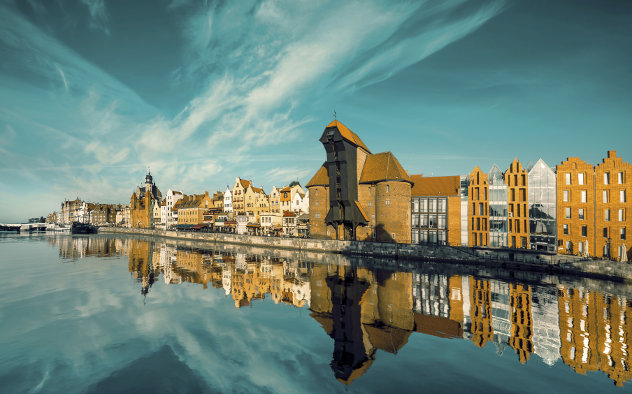Mortgage market in Poland: booming housing market
Kop-Munt, Tuesday, 12 September 2017

The Polish real estate market experienced an increase last year. 163,000 new houses were completed, and the country issued 81,000 permits for new homes currently under construction. The building sector, the European Mortgage Federation concludes, is the best one in ten years.
The booming market is often concentrated in the large Polish cities, where the demand for housing is high, and property developers are pulling new flats out of the ground. In the outlying areas, it is mostly private individuals who build a dream house on their plot of land.
Many houses paid cash
The housing market boom did not translate into records for mortgage lenders. There is some extraordinary evidence: according to estimates by the NBP, the Polish National Bank, up to 70% of all transactions in the seven largest cities were settled in cash last year. According to analysts, Polish investors have massively invested their savings in real estate, because renting out housing is seen as a sound investment.
In 2016,170,000 mortgages were granted in Poland, a total of EUR 92 billion in residential mortgages outstanding at the end of last year. On average, a Pool pays 4.4% interest, and almost half of the new mortgages taken out have a Loan-to-value of more than 80 percent. Since the beginning of last year, lenders have only been allowed to accept a Loan-to-value of over 85 per cent under stringent conditions. It is striking that Poland has almost exclusively variable interest rates: banks hardly offer a fixed-interest period of more than one year.
Banks in Poland hold 99% of the market, while credit unions have signed up for the last percent. Since 2015, Poland has had three specialized mortgage banks: PKO Bank Hipoteczny, Pekao Bank Hipoteczny and mBank Hipoteczny. Three major retail banks have not yet considered setting up their mortgage bank, according to analysts of the European Mortgage Federation (EMF). The Polish mortgage market is therefore developing strongly, and the market for (independent) mortgage advisers has also got off the ground since the country joined the European Union in 2004.
Foreign currency favorite
Polish banks have provided a significant proportion of their mortgage loans (both residential and commercial) in exchange. In total, this amounts to USD 42 billion. The government has been developing legislation for years that forces banks to convert the loans into zloty. Discussions focus on the exchange rate to be used by banks and on which loans should be converted. An overly rigorous implementation of the plans could damage the Polish mortgage market, warning the banks.
Grants for start-ups
The Polish Government has a subsidy for Poland under 35 years old who want to buy a first house of 10% of the construction value of an apartment of up to 75 square meters. If you have three children, you can even qualify for a 30% subsidy, but the flat may not be larger than 85 square meters - or 110 square meters for a house. Mortgage lenders calculate the value of this subsidy as part of equity.
 This article of is subject to a license. Based on . Translated from the Dutch
language by Jos Deuling.
This article of is subject to a license. Based on . Translated from the Dutch
language by Jos Deuling.

The Polish real estate market experienced an increase last year. 163,000 new houses were completed, and the country issued 81,000 permits for new homes currently under construction. The building sector, the European Mortgage Federation concludes, is the best one in ten years.
The booming market is often concentrated in the large Polish cities, where the demand for housing is high, and property developers are pulling new flats out of the ground. In the outlying areas, it is mostly private individuals who build a dream house on their plot of land.
Many houses paid cash
The housing market boom did not translate into records for mortgage lenders. There is some extraordinary evidence: according to estimates by the NBP, the Polish National Bank, up to 70% of all transactions in the seven largest cities were settled in cash last year. According to analysts, Polish investors have massively invested their savings in real estate, because renting out housing is seen as a sound investment.
In 2016,170,000 mortgages were granted in Poland, a total of EUR 92 billion in residential mortgages outstanding at the end of last year. On average, a Pool pays 4.4% interest, and almost half of the new mortgages taken out have a Loan-to-value of more than 80 percent. Since the beginning of last year, lenders have only been allowed to accept a Loan-to-value of over 85 per cent under stringent conditions. It is striking that Poland has almost exclusively variable interest rates: banks hardly offer a fixed-interest period of more than one year.
Banks in Poland hold 99% of the market, while credit unions have signed up for the last percent. Since 2015, Poland has had three specialized mortgage banks: PKO Bank Hipoteczny, Pekao Bank Hipoteczny and mBank Hipoteczny. Three major retail banks have not yet considered setting up their mortgage bank, according to analysts of the European Mortgage Federation (EMF). The Polish mortgage market is therefore developing strongly, and the market for (independent) mortgage advisers has also got off the ground since the country joined the European Union in 2004.
Foreign currency favorite
Polish banks have provided a significant proportion of their mortgage loans (both residential and commercial) in exchange. In total, this amounts to USD 42 billion. The government has been developing legislation for years that forces banks to convert the loans into zloty. Discussions focus on the exchange rate to be used by banks and on which loans should be converted. An overly rigorous implementation of the plans could damage the Polish mortgage market, warning the banks.
Grants for start-ups
The Polish Government has a subsidy for Poland under 35 years old who want to buy a first house of 10% of the construction value of an apartment of up to 75 square meters. If you have three children, you can even qualify for a 30% subsidy, but the flat may not be larger than 85 square meters - or 110 square meters for a house. Mortgage lenders calculate the value of this subsidy as part of equity.
 This article of is subject to a license. Based on . Translated from the Dutch
language by Jos Deuling.
This article of is subject to a license. Based on . Translated from the Dutch
language by Jos Deuling.

All types of property for sale in Poland by private sellers and estate agents. Find your villa, farmhouse or apartment in the Mazowieckie, Malopolskie, Pomorskie or Dolnoslaskie region.
 Foreigners are increasingly interested in buying property in Poland and they are buying significantly more apartments than in the previous years. The
nationalities most heavily active in the Polish real estate market include Germans, Spaniards, Ukrainians, Britons and the Irish. 40% of properties are
bought in the Mazowieckie voivodship, followed by Malopolskie, Pomorskie and Dolnoslaskie voivodships. Typically, foreigners look for real estate in
large cities such as Warsaw, Cracow, Wrocl
Foreigners are increasingly interested in buying property in Poland and they are buying significantly more apartments than in the previous years. The
nationalities most heavily active in the Polish real estate market include Germans, Spaniards, Ukrainians, Britons and the Irish. 40% of properties are
bought in the Mazowieckie voivodship, followed by Malopolskie, Pomorskie and Dolnoslaskie voivodships. Typically, foreigners look for real estate in
large cities such as Warsaw, Cracow, Wrocl